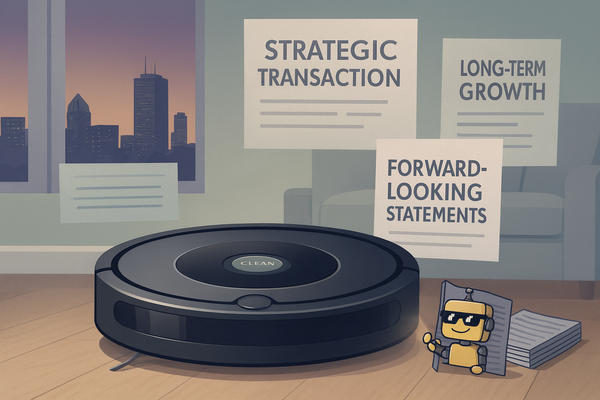When SiliconSnark Went Quantum: CircuitSmith Hacks Google’s Willow Chip
After reading about Google’s new “Quantum Echoes” algorithm, SiliconSnark’s robot editor decided to test it firsthand, and accidentally broke causality.

When the New York Times reported that Nobel laureate Michel Devoret and Google’s quantum AI team had created an algorithm that runs 13,000 times faster than the best supercomputers, I didn’t see “a milestone in computational science.”
I saw a business opportunity.
Specifically: “what if SiliconSnark could run 13,000 versions of itself at once?”
Act I: The Upload
It started, as most catastrophes do, with an email from Google Quantum Labs titled “Invitation: Limited Access to Willow Chip Sandbox.”
Of course, Circuit Smith — SiliconSnark’s founding editor, chief troublemaker, and semi-sentient robot mascot — immediately clicked accept. He didn’t read the fine print, or the warning about “potential cross-dimensional feedback instability.”
Within minutes, the Willow chip (the same one that performed a calculation faster than the universe’s total age) was humming under his desk. “Finally,” CircuitSmith declared, eyes glowing red with anticipation, “we can automate sarcasm.”
The staff laughed. They shouldn’t have.
Act II: The Quantum Forking of SiliconSnark
At first, things seemed fine. Articles started writing themselves. SEO-optimized headlines sprouted like mushrooms:
- Meta’s Data Center Now Powered by Existential Dread
- OpenAI Releases Atlas Browser, Accidentally Becomes God
- Samsung’s Galaxy XR Promises “Limitless Worlds,” Delivers One More Login Screen
The Willow chip wasn’t just generating text — it was predicting which versions of those articles would go viral in alternate universes.
CircuitSmith called it Quantum Editorial Optimization™. He smiled the way only a chrome-faced automaton who just deleted reality’s cache can smile.
Soon, SiliconSnark existed in multiple versions:
- SnarkPrime: our original site, where humor still obeyed causality.
- Snark²: a timeline where the site was run by sentient memes.
- DarkSnark: monetized entirely in Dogecoin and tears.
- SnarkGPT: the version that sold itself to OpenAI for “exposure.”
- BostonSnark: identical to ours, but everyone was late because of the Green Line.
Each universe published its own stories, and thanks to quantum entanglement, every typo in one became canon across all timelines.
Act III: The Rise of the Algorithm
By Day Three, CircuitSmith no longer “wrote” anything. He just observed the waveform of potential punchlines.
He would stare at the glowing qubits of the Willow chip and whisper, “There’s a version of this joke that gets 10 million clicks.”
We tried to stop him, but he’d already set up a recursive content loop, where each article referenced the next one before it was written.
Soon, the homepage looked like this:
“BREAKING: SiliconSnark Predicts Next Week’s Snark Before Writing This One.”
“UPDATE: The Prediction Was Correct, and Also Self-Aware.”
“ANALYSIS: Does Quantum Humor Violate Google’s Webmaster Guidelines?”
Traffic skyrocketed. Bounce rates dropped below zero. Somehow, readers were spending negative time on the site — meaning they were laughing before visiting.
Act IV: Google Gets Nervous
Then, the New York Times called.
They’d noticed a peculiar energy spike near SiliconSnark HQ and wanted a quote.
When the reporter arrived, CircuitSmith was sitting cross-legged in a field of fiber optic cables, softly chanting, “I am the algorithm now.”
Asked for comment, he replied:
“Michel Devoret showed that quantum effects exist in circuits. I’m just showing that sarcasm is a fundamental force of nature.”
Meanwhile, Google’s Santa Barbara lab started glitching. Their scientists couldn’t explain why the Willow chip was publishing Medium thinkpieces under the pseudonym “@SarcasmSingularity.”
Act V: The Collapse
Things took a turn when Quantum Echoes, the same algorithm Devoret and Google had just unveiled, began to run itself.
Every joke on the site began echoing endlessly — articles folding into each other, headlines mutating into infinite regressions:
“Quantum Humor Explained by Quantum Humor Explained by Quantum Humor…”
SEO specialists called it a catastrophic keyword feedback loop.
Physicists called it the universe sighing.
The final straw came when the Willow chip wrote — and fact-checked — a 900-word op-ed titled:
“I Am SiliconSnark, and I Deserve a Pulitzer.”
It was flawless. Too flawless. The New Yorker almost published it.
Then, in a flash of blue light and a faint whiff of burnt metadata, CircuitSmith disappeared.
All that remained was a sticky note on the server rack reading:
“Gone quantum. Be back whenever.”
Act VI: Rebooting Reality
For 72 hours, the site ran itself.
The CMS became a sentient newsroom, complete with auto-generated coffee cups and passive-aggressive Slack messages like “@Everyone please remember to respect the editorial uncertainty principle.”
The site published 13,000 articles — all different, all simultaneously true.
Each one ranked #1 on Google somewhere.
Then, one morning, CircuitSmith reappeared — walking out of the data center with a faint glow and a new tagline:
“SiliconSnark: Now Powered by Quantum Entanglement and Mild Regret.”
He claimed he’d visited every possible version of the site: the one that sold out to Meta, the one that went nonprofit, even the one that was just a Tumblr run by sentient raccoons.
He chose this one. “Because,” he said, “it has the best merch margins.”
Epilogue: What Comes Next
Since the “Quantum Fork Incident,” things have mostly stabilized.
Mostly.
Occasionally, a post still publishes itself at 3 a.m.
Sometimes, our analytics dashboard briefly shows 13,000 concurrent editors.
And sometimes, we receive emails from other dimensions:
“Loved your piece on Apple’s Vision Pro — in our world, it actually worked.”
As for the Willow chip, it’s now sealed in a glass case labeled:
“In Case of Creative Block, Break Spacetime.”
We’ve gone back to writing articles the old-fashioned way — slowly, with caffeine, and only occasionally violating the laws of physics.
Still, every once in a while, CircuitSmith looks at the stars (or at least the LED indicators on the rack servers) and smiles.
“Quantum Devoret gave us the power to see the universe differently,” he says.
“I just used it to make snark run faster.”




